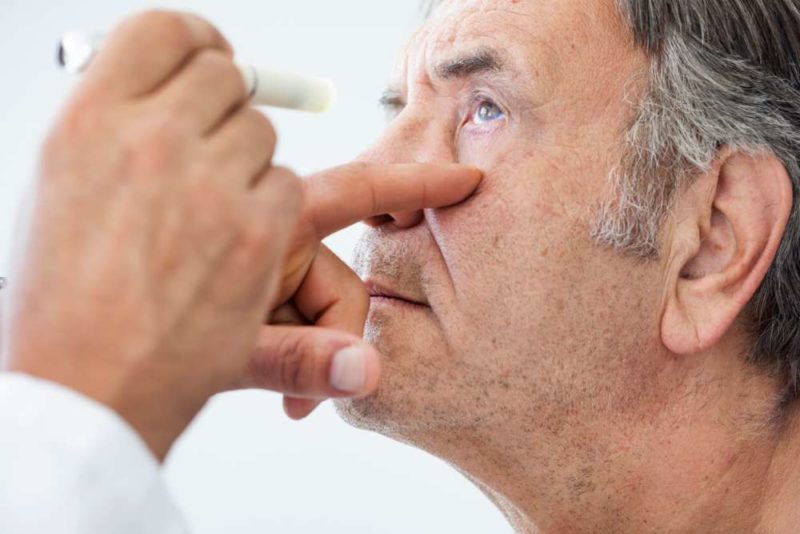
Eye miosis occurs when the pupil in the eye shrinks and doesn’t re-enlarge.
Normally, pupil size dilates (enlarges) and shrinks in reaction to light and sometimes, strong emotions. Pupils dilate in dim light to allow more light in and shrink down to a small dot when exposed to bright lights.
In the case of abnormal eye miosis (also called pinpoint pupil, miosis eye or just miosis), the pupil remains small. If this happens suddenly and is not understood to be part of a diagnosed condition, it can indicate something is seriously wrong. Get medical attention right away.
What Causes Miosis Eye?
“Mama always told me not to look into the sights of the sun,” Bruce Springsteen wrote. Good advice, but that won’t cause miosis eye. For that matter, neither will mad men, drummers, or bummers.
There are a lot of causes behind miosis.
- An eye injury can cause inflammation and swelling behind the eye, which makes it more difficult for the pupil to react to light.
- Uveitis is one condition in which inflammation that the eye’s middle layer — the area between the sclera (whites) and inner eye layers that can cause miosis.
- Medication side effects can shrink pupils, particularly narcotics, Valium, and antihistamines.
- Genetics: some people inherit a gene that prevents the development of the muscle that controls pupil size. Many are nearsighted, and they are more likely to have glaucoma.
- Age: most newborns have small pupils in the first couple of weeks while their eyes adjust to the outside world. Pupils also shrink with age — one reason why older people have trouble seeing at night.
- A severe lack of Vitamin D can cause a host of optical problems, including mitosis eye.
A rare disease called Horner’s Syndrome disrupts communication between the brain and parts of the face, including the eyes, and can shrink one or both pupils. Horner’s can be inherited or it can be triggered by a neck injury, neck surgery, brain tumor, and shingles. Neurosyphilis, which occurs when untreated syphilis bacteria enter the brain, can also trigger mitosis.
Miosis Eye Treatment Depends on the Cause
Miosis is usually viewed as a possible symptom for a more serious condition or disease like those listed above. It can be an important clue to confirm other diseases and conditions, as well such as cluster headaches, brainstem stroke, and Lyme disease.
Miosis caused by inflammation after an eye injury is treated with eye drops that force pupils to dilate, such as atropine or homatropine. They can work for up to two weeks.
Otherwise, miosis is most likely to improve through treatment for underlying diseases and conditions.
- Cluster headaches, which often have several eye-related symptoms such as drooping eyes and light sensitivity, have been successfully treated with corticosteroids, blood pressure medication, and melatonin that have also relieved miosis eye.
- Antibiotic treatment for Lyme disease has cleared up associated infections and relieved miosis and other symptoms.
- Standard stroke treatment like stents or medication to dissolve the blockage can clear up associated symptoms.
- Adults with Vitamin D deficiency are initially treated with large doses of the vitamin — 50,000 IU of D3 once a week or 6,000 IU daily for eight weeks followed by a maintenance regimen of 1500 – 2000 IU each day.
Treatments for Horner’s Syndrome focuses on its treating the triggers underneath it.
If you have questions about your eyes and conditions or diseases that affect them, contact one of our offices for a consultation. Any unusual change in your eyes should be examined by a physician or ophthalmologist as soon as possible.
Contact Us
If you have more questions about LASIK procedures, get in touch with us.
Related Blogs

Who Should Not Have Laser Eye Surgery
Laser eye surgery, commonly known as LASIK (Laser-Assisted In Situ Keratomileusis), has revolutionized the world of vision correction. It’s a procedure that has enabled millions

LASIK eye surgery: What is LASIK and how does it work?
What Is LASIK? Experts categorize LASIK as a refractive eye surgery in which lasers are used to correct vision problems. LASIK corrects several refractive errors,

Everything You Need To Know About The Lipiflow Treatment
LipiFlow is often referred to as a ground-breaking technology that is able to treat dry eye issues caused by meibomian gland dysfunction, or MGD. Experts
